Notes from our May 13, 2022 Meeting
We had most of the “hard-liners” turn out for the meeting. Dean, Keith, Hank, Harry and I were present for our 80th meeting. It was only a short 8 weeks since our previous meeting but the weather has gone from snow shovels to salt tablets for the heat and humidity. The Chicago area always provides a variety of weather.
We launched into our introductory topics at 7:15 with a quick view of the trailer for the Netflix documentary of the DM2 first manned Dragon mission named “Return to Space”. It is amazing how quickly the 2 years have gone since the May 30, 2020 launch of the “space dads”, Bob and Doug. Both astronauts are married to NASA astronauts and Bob’s wife actual got to sit in the same seat as he did on her CREW2 mission to the ISS. That Endurance Dragon capsule also hosted the recent Axiom-1 mission of private astronauts to the ISS. SpaceX has launched 26 people into space on Dragon and I don’t think Boeing will ever catch up with them on the Starliner capsule. It seemed like a simpler time 2 years ago watching Bob and Doug play with their sparkly dinosaur named “Tremor” which served as their 0-G indicator. It was also a little sad to see Armstrong and Cernan, two of our pioneer Apollo astronauts, testifying to Congress on what a mistake it was for NASA to fund Commercial Crew capsules. It brought Elon Musk to tears to see his heroes being so against what he was trying to do. I highly recommend the 2 hour documentary.
We need did a quick conversation about Blue Origin. Their lead rocket engine designer recently left the company. I’m a little concerned because they are late in developing a very critical BE-4 methane burning engine. The BE-4 will be the power for ULA’s new Vulcan rocket which won the contract to launch 60% of the DoD’s military satellites. With the Atlas 5 rocket and its Russian engine being phased out, ULA only has a couple dozen here in the US. Blue Origin made some news by purchasing 83 rocket launches for their “Internet-from-Space” Kuiper constellation of 3,236 satellites. 18 launches are on the soon to be developed European Ariane 6 rocket, 12 to 27 launches on Blue Origin’s New Glenn rocket which also will need the BE-4 engine, and about 47 launches on Atlas 5 and Vulcan rockets from ULA. Kuiper will be a direct competitor of SpaceX’s Starlink service. So far no Kuiper satellites have launched, SpaceX has launched 2600 Starlinks, most of which are functional. Starlink as a service is in 32 countries and has about 150,000 daily users in Ukraine, much to the dismay of Russia. The last Blue Origin topic is that they are launching another of their sub-orbital New Shepard missions, NS-21, on May 20. This time it touts the first Mexican born woman and a repeat rider, Evan Dick.
Next, I shared some Moon facts with the group. I recently caught up on 18 months of astronomy magazines and shared some common misconceptions about the moon from a Bob Berman article in the October 2021 Astronomy Magazine. First fact, is how many moons would it take to go from the horizon to the zenith over head? Most people guess 30-50 but the correct number is 180. The moon is about a half degree in diameter and there are 90 degrees from horizon to zenith. In space the moon is one fourth the earth in diameter which is clearly shown in this picture from the DISCVR spacecraft which orbits at the L1 Lagrange Point between the earth and the sun. Note that the moon is showing its fully illuminated far-side which is a little brighter than the side we see from earth because it has less dark maria. Second fact, what is the albedo of the moon? Using a scale of 0 being totally black to 100 being totally white?
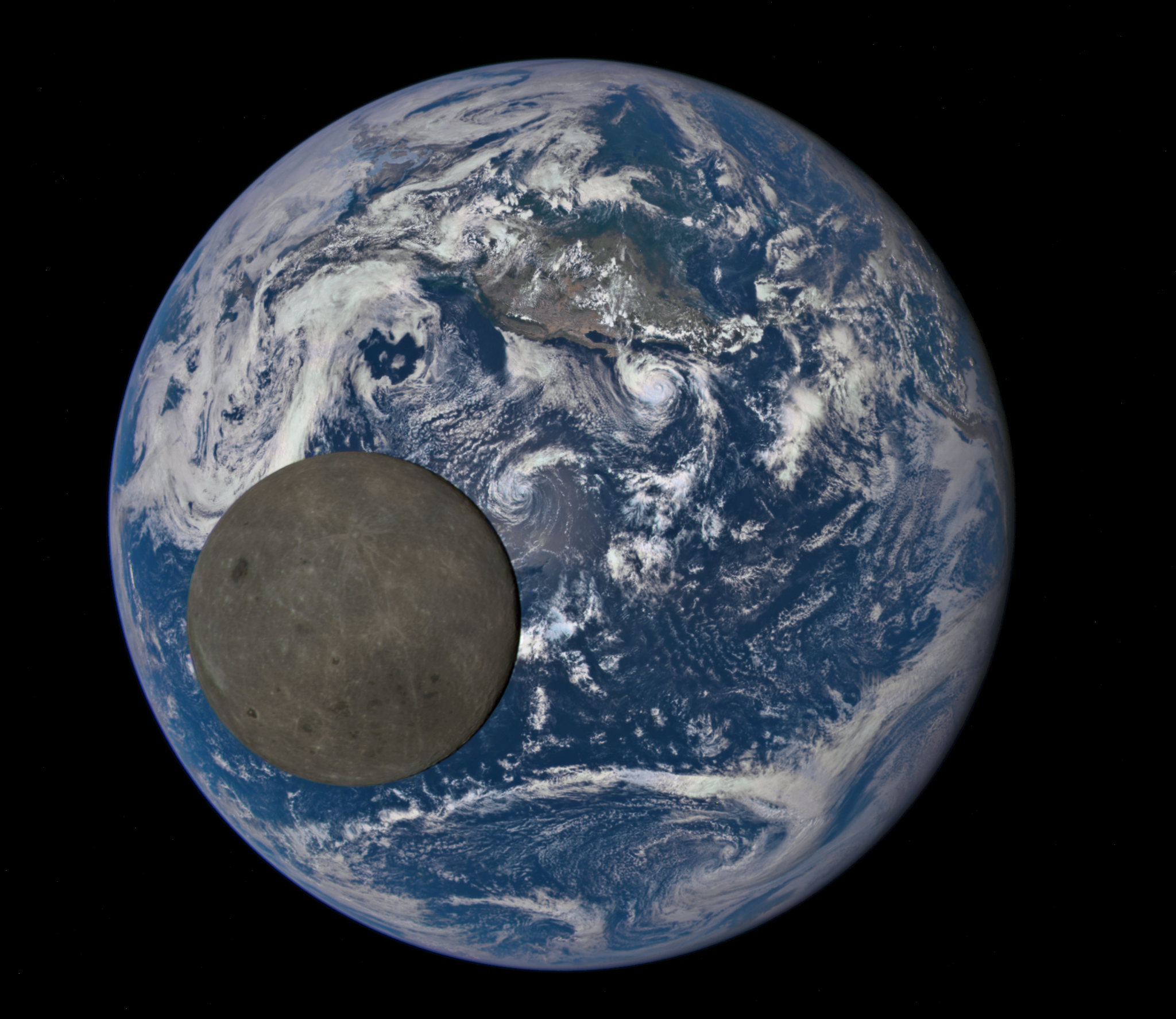 Most people guess about 50. Actually it is 11 for the moon. Much darker than people think. Dark forest foliage is 15 and charcoal is 5. The last moon fact is, how much dimmer is full moon light compared to full sun light? Most people guess that moonlight is 10-100 times dimmer than sunlight. In fact, moonlight is 450,000 times dimmer than sunlight. This goes to show how great the human eye is in adjusting to difference light conditions. I squeezed in one more fact from Bob Berman with the factoid that if you drive 38 mph or less, you won’t get any bug splats on your windshield (page 13 March 2022 Astronomy Magazine). This maybe helpful with summer driving coming up.
Most people guess about 50. Actually it is 11 for the moon. Much darker than people think. Dark forest foliage is 15 and charcoal is 5. The last moon fact is, how much dimmer is full moon light compared to full sun light? Most people guess that moonlight is 10-100 times dimmer than sunlight. In fact, moonlight is 450,000 times dimmer than sunlight. This goes to show how great the human eye is in adjusting to difference light conditions. I squeezed in one more fact from Bob Berman with the factoid that if you drive 38 mph or less, you won’t get any bug splats on your windshield (page 13 March 2022 Astronomy Magazine). This maybe helpful with summer driving coming up.
I shared some aurora photos that my son, Curt, recently took in Denali Park in Alaska. I envy his view but I’m not sure I’d want to be tent camping with 4 feet on snow on the ground. The sun is heading to a maximum of activity in a couple of years and the trend so far is that it is exceeding expectations for solar activity. All the pictures are hand-held Iphone shots of about 20 seconds exposure.
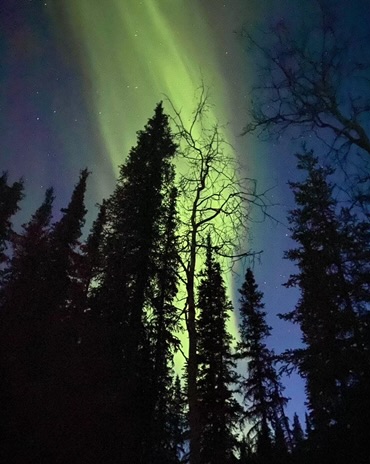
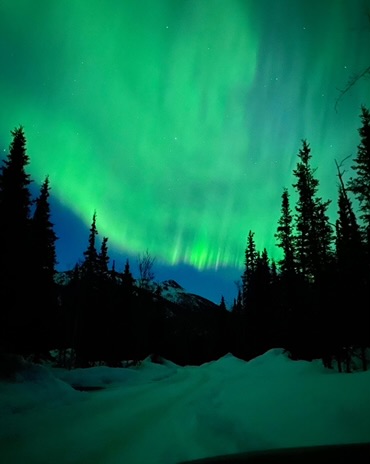
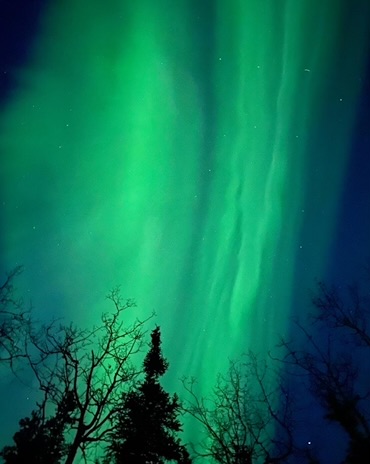
Saturday April 23 was Astronomy Day at Harper College. Kevin Cole, Dean and Beth were among the speakers. I attended 3 interesting talks on cosmology, Kevin’s talk on the Europa Clipper and Solar System evolution. Dean’s talk was on the SLS rocket and Beth spoke of her analog astronaut experiences.
The next day, Sunday April 24 was the CSSS meeting with speaker David Brin in Schaumberg. David Brin is an accomplished science fiction writer as well as being involved with NASA’s NAIC program that funds innovation ideas with small seed money. He is very opiniated and felt the US will be taken over by a new group of oligarchs and that we should storm Boeing headquarters with lighted torches because of their failings on Starliner and the core stage of SLS. He felt the moon isn’t worth setting a base on because it lacks metal resources. A better goal is to go to asteroids. He also feels Putin will destroy LEO with anti-satellite tests. He likes the Artemis program space station around the moon called the Gateway but feels SLS is sucking all the resources out of NASA. He has a couple of his books in print. I like “The Postman” which has been turned into a Kevin Costner movie and “Existence” which I am having a hard time reading.
Just before the meeting I was able to watch the “Conversations with Joe” podcast with Andy Weir. Andy is famous for his first book, “The Martian” and they talked about his second book “Artemis” and third book “Project Hail Mary”. Both books are in development as movies. I’ve read both books and enjoyed them. “Project Hail Mary” is very inventive with an alien crab creature and look forward to see how that would be brought to the screen.
Last intro topic is that there is a total lunar eclipse May 15-16 (Sunday – Monday). The peak is 11:11 PM on Sunday night and it starts at 9:28 PM. Sometimes lunar eclipses can be like watching paint dry, but if it is clear I’ll check it out to see how red the moon gets.
Starship versus SLS
We then moved to the main topics. I wanted to know if the group felt whether SLS or Starship would go orbital first and whether they still felt if Starliner is worth NASA’s funding. Everyone felt SLS will launch first. I’m not so sure, SLS will need a new attempt at “wet dress rehearsal” which could delay it to August. If the FAA give SpaceX the OK to launch Starship from Boca Chica, they could get Starship into orbit in July. Time will tell. On Starliner, everyone agreed that Boeing has been lax on development and a little angry on the amount of money they have received with no docking to ISS yet. But Starliner’s orbital reboost capability is needed if the Russia leave the ISS and it never hurts to have redundant capability to send people to ISS. It’s just the fact that Starliner seats will cost $90 million whereas Dragon seats only cost $55 million, how many flights will NASA need? Starliner could have a role to play in later Commercial space stations. Boeing’s unmanned OFT-2 mission of Starliner is scheduled for May 19, we wish it success.
Here is the background on SLS versus Starship issue. This site weighs in on what the FAA delay might be caused by. The Ground Support Equipment for both SLS and Starship is extremely important and is sometimes referred to as Stage 0 of the rocket. Marcus House talks about many of the issues. In March Elon Musk predicted Starship would go orbital in May 2022 but we all know about “Elon time”.
Comparing Starship to SLS, the Starship/Super Heavy weighs in at 5000 mt which is twice what the initial SLS Block 1 weighs. 4600 mt of the Starship/Super Heavy is propellant. The Super Heavy (SH) has 33 Raptor 2 engines, with an outer ring of 20 fixed engines and 13 gimbaling ones in the center. SH holds 3400 mt of propellant and generates 16.7 million lbs of thrust, twice that of the Saturn 5. The Falcon Heavy by comparison generates 5.1 million lbs of thrust. The upper stage, Starship, has 6 Raptor engines, 3 optimized for vacuum and 3 for sea-level operation and contains 1200 mt of propellant.
My last comment was that the Artemis female manikins from the European Space Agency are a little too anatomically correct. Here are Helga and Zohar. The pictures look a little creepy, especially the last picture with the tech standing with his hands behind his back and a reclined manikin in the foreground.
Starliner and Crew Dragon
We then moved on to our second question, is Starliner still needed? Starliner has been stacked on its Atlas 5 rocket prepping for its May 19 launch. The rollout to the rocket had a small mishap when the cover to one of the capsule’s windows fell off, hopefully that is not an omen for the success of the mission. See the William Harwood Twitter video on this site. The mission is designated OFT-2 and is a planned to be docked for 1 week to the ISS. OFT-1 was Boeing’s first attempt on December 20, 2019, over 2 years ago. The first attempt to launch OFT-2 was over 8 months ago but stuck valves on the attitude thrusters prevented a launch. Boeing has added nitrogen purge capability to the valves to prevent infiltration of humid Florida air into the devices. The Angry Astronaut has a good summary of Boeing’s efforts with Starliner and whether NASA should continue funding it. Boeing got paid $4.2 billion to develop Starliner compared to SpaceX only getting $2.6 billion for crewed Dragon. Then Boeing effectively demanded an extra $287 million more from NASA to continue Starliner development and additionally got NASA to pay it $374 million more for Soyuz seats because Commercial Crew was delayed. They still haven’t put an astronaut in space whereas SpaceX has flown 26 people into space on the Dragon. Even if Starliner begins flying people, they will charge NASA $90 million per seat compared to the $55 million that SpaceX prices Dragon seats. For a typical mission with 4 astronauts, that is an extra $140 million cost for a Starliner mission.
Tenacity the first Dream chaser is set to launch on a Vulcan rocket as early as Feb of 2023 and Sierra Space still hopes to have it man rated by 2026. The first launch is as a supply mission for ISS. Maybe we should take our Starliner money and redirect it to Dream Chaser. The space plane can provide reboost of the ISS as can the Starliner.
There are numerous bets and wagers on which rocket will fly first. The Angry Astronaut has a wager that he will get a butt tatoo of “SpaceX fanboy” if Starship goes orbital before Peregrine lander launches on the first Vulcan rocket. Most comments from the Internet is hopefully we won’t have to watch. Everybody seems to have a contest regarding which rocket flies first. Frasier Cain of Universe Today, has a contest whether he will get to 1000 patrons of his podcasts before SLS and/or Starship goes orbital.
SpaceX
SpaceX and Northrop Grumman each got 6 more cargo missions to the ISS. This will take SpaceX up to the CRS-35 mission. Northrop has only 2 Antares rockets for their Cygnus capsule, so they will have to transition to the Vulcan rocket to fulfill the contract.
SpaceX launched the first private Dragon mission, Axiom-1, to the ISS with 2 Americans, a Canadian and an Israeli for 10 days in space and 8 days docked to ISS. The astronauts plan to do numerous experiments. Axiom eventually wants to build a commercial space station to replace the ISS. SpaceX charged $55 million a seat on Dragon and NASA will charge $22,500 per person per day for food, air and toilet usage. Bad weather extended the mission about an extra week but NASA said they won’t charge for the extension.
Just after Axiom-1, SpaceX launched CREW4 to the ISS for a 6 month stay. This makes 26 people that SpaceX has launched into space, with 16 for NASA and 4 on the Inspiration4 mission and 4 on Axiom 1. According to SuperCluster with CREW4, 625 people has now gone into space and the ISS has hosted 457 visits by 258 different people and with 199 return visits. Jessica Watkins, one of the CREW4 rookie astronauts, is a geologist by training and had Apollo astronaut Harrison Schmidt watch the launch. He looks pretty good for his age and may be our best chance of having an Apollo moon walker alive when we first land again on the moon. She is very qualified technically and satisfies the political aspect also in that she is a “two-fer” (black and female). I think she has a very good chance of being on that first Artemis landing mission. So far in 2022, we’ve had 3 cosmonauts launch on March 18, 6 people on New Shepard on March 31, 4 on Axiom1 on April 25 and now 4 on CREW4 on April 27, for a total of 17 people. Looks like 2022 could set a new record for days in space. In 2021 we had 3198 days in space at a monthly rate of 267 per month and so far in 2022 our rate is 318 per month thru April. As of end of April, we have accumulated 167+ years of time in space with 82+ years by the Russians, 65 years by the US and 20 by other countries.
Lastly in SpaceX news, the company is soon to launch Psyche launch in August 2022. This will probably be the first Falcon Heavy launch since June 2019, a 3 year hiatus. Part of the lack of Falcon Heavy launches is that some of the DoD satellites have been chronically delayed. One of them was planned for September 2020. Falcon Heavy debuted in February 2018 with the launch of a red Tesla and has had a total of only 3 flights. Both launches on Falcon Heavy will expend the central core of the rocket but the side boosters should return to earth intact. Psyche is a 2.6 mt (5700#) spacecraft. Psyche’s launch should be one of the more predictable launch dates because orbital mechanics dictate that its launch window is a narrow 20 days starting August 1. Here is the NASA Psyche trailer video. Psyche will use solar electric power which is 5 times more efficient than chemical propulsion. It will be used to propel the spacecraft on its 3.5 years cruise out beyond Mars and will arrive at its destination in 2026. A gravity assist from Mars will also add some speed to the craft.
James Webb Space Telescope (JWST)
The Hubble Telescope is getting ready to pass the torch to JWST. Hubble just turned 32 years old. In those years, Hubble has taken 1.4 million pictures but imaged only .8% of the sky. It would take another 3.2 million images with its 202 arc second field of view for a complete view of the entire sky.
JWST has completed its optical alignment. Optical performance better than most optimistic predictions. In this test picture is of the Large Magellanic Cloud, each instrument points at a different part of the sky. The telescope will now move on to instrument commissioning of each mode. Here is a comparison of JWST resolution compared the the other infra-red space telescopes of Spitzer and WISE. You can follow along on the progress on the JWST home site which has a display showing the 17 instrument modes of operation and their status.
Mars
The Ingenuity helicopter stopped responding after it made 28 flights and traveled 7 km. Dust on its solar panels and the approach of Mars winter in the coming 10 weeks, made it lose contact on May 3. NASA ordered the nuclear powered Perseverance rover to stay quiet for a full day and listen for the helicopter’s call. Mars temperatures get down to -100 degrees F. The copter did call in after about 24 hours and stable communication link was established. In the future NASA will minimize battery drain by only putting the copter’s heaters on when the temperature drops to -40 degrees rather than the previous 5 degree mark.
NASA has decided to split the Mars sample return mission into two separate landers. The split was so that proven landing techniques like the sky-crane on the Curiosity and Perseverance rovers could be used again. The original plan was to launch in 2026 with a ESA rover and the Mars Ascent Vehicle (MAV). MAV will launch up to a Mars orbiting spacecraft that will return the samples to Earth in 2031. Now the 2 landers will launch in 2028. The Earth Return Orbiter will launch 1 year earlier in 2027 and the samples will return to earth in 2033. The SRL1 spacecraft will carry MAV and SRL2 will carry the fetch Mars rover. Last year the sample return mission was estimated to cost $7 billion. Another complication is that the ExoMars rover mission has been delayed from a Soyuz launch this September. The European Space Agency (ESA) now plans for a launch possibly in 2026. ESA might partner with NASA again on getting the rover to Mars.
The Perseverance rover had reached the river delta. Here is a short Mars Guy video showing the path of the rover. Another good video describes some of the troubles with the wayward helicopter. This last video talks about the potato rock hitchhiker and the “bacon strip” rock formation that seems to be the rover’s destination. Go to the rover’s home site to follow the rover and you can optionally turn on layers of the map that will show the helicopter route and waypoints.
Lastly the Angry Astronaut weighed in on the danger of bringing Mars samples back to the earth’s surface. He believes the Viking experiments proved that there are Mars microbes currently on the surface. I don’t think that is the current consensus of scientists and the Mars samples will be encased in their metallic tubes anyway.
Astronomy
Astronomers have reached the 5000 mark in confirmed exoplanets and we are still alone. 65 of the newly confirmed planets were identified this week bringing the tally to 5005. The exoplanets range from tinier than Mercury to double the size of Jupiter, ice cold to scorching hot, rocky with a surface to gaseous with clouds all the way down, ones around the closest star, Proxima Centauri, 4.2 light years away and others a couple of 1000 light years distant. It is estimated that the Milky Way must have more planets than stars. The first exoplanet was found in the early 1990s using ground based telescopes. The Kepler space telescope started the discovery explosion (2/3 of the exoplanets are from its candidates). We have hot Jupiters very close to their stars, exoplanets in the “Goldilocks Zone” where liquid water could exist, and all other sorts of objects. We’ve yet to find a truly Earth-like planet, a rocky world about our size, with a chemically rich atmosphere and surface temperatures that allow water to stick around in liquid form. The SETI search continues. Are the odds 100 billion to one or only 100 million to one, the more discoveries we make increases our chances of finding alien life. Will the discovery be microbial or something more advanced?
A picture has been created for the black hole at the center of the Milky Way. Veritasium video describes the discovery. The apparent size in the sky of the black hole is like a donut on the moon’s surface viewed from earth.
The farthest galaxy and the farthest star have been discovered. The farthest galaxy, HD-1, is 100 million more light-years distant at 13.5 billion light-years than GN-z11 the previous record holder. Ground based telescopes observed it. HD-1 is considered a starburst galaxy forming 100 stars per year, a rate 10 times higher than typical starburst galaxies and 100 times the 1 star per year of the Milky Way. It might be home to the first generation of stars, called Population III, that might be 500 times the mass of the Sun. The farthest star, nicknamed Earendel, was found by the Hubble Telescope in a gravitational lensed arc. It is also thought to be a Pop III star. Lensing increased its brightness by 1000 times. Both objects will be observed using JWST.
Comet discovered in 2014 determined to be the largest so far found. It first discovered back in 2014 and named C/2014 UN271. Subsequently it was determined to be about 120 km across or about 10 times the diameter of Halley’s Comet. It will never be visible to the naked eye because it doesn’t get close enough to the sun. It is 3 billion km away now and closest approach will be in 2031 when it will be no closer than 1.6 billion km from the sun or about Saturn’s distance. The nucleus of the comet only reflects 3% of light, so it is blacker than coal. Its orbit takes 3 million years and is highly elliptical. At its farthest, the comet will be a half light year from the sun or one eighth the distance to the nearest star.
What is Dark Matter? Paul Sutter does a good job describing it in this new series he is making for ARS Technica video.
NASA
On March 30, 2022, Mark Vande Hei returned to earth after the longest US stay in space with 355 days, beating Scott Kelly’s 340 days.
Apogee does a great review of the 3 competing space station designs in this video. In a more written account, NASA awards $415 million to Blue Origin (Orbital Reef with Sierra Space got $130 million, baseline configuration will begin operating in 2027), Nanoracks (Starlab with Lockheed Martin got $160 million, launch in 2027) and Northrop Grumman (unnamed got $126 million) for stations. Axiom which got $140 million from NASA earlier to attach a habitation module to ISS, did not bid for CLD. Apogee posits who he thinks has the best design and who he thinks NASA will select. It is a new bid program call CLD (Commercial LEO Destinations) with $400 million to as many as 4 companies. Modeled after other Commercial programs. Teams include: 1) Axiom; 2) Blue Origin (BO) with Orbital Reef; 3) Lockheed & Nanoracks with Starlab; and he thinks there may be a 4th entry of SpaceX with Starship. 2022-2025 is development and 2026 begins operation. He mentions HLS from Blue Origin because BO’s Orbital Reef is the most ambitious plan. He thinks Axiom and BO will be picked. In March 2021, NASA thought the first round of funding would be in October and December 2021.
Angry Astronaut weighs in on the Orbital Reef design in this video. He talks about troubles with Russia, Sierra Space Dream Chaser, Blue Origin and New Glenn rocket.
NASA lays out plans for a second lunar lander for HLS. Apogee’s video does a good job explaining the nuances of the HLS contracts and their appendixes and clauses. A good point he makes, is that NASA talks about the advantages of redundancy and competition in HLS but completely refuses to consider it in discussions about SLS/Orion. SpaceX has won 1 uncrewed and 1 crewed moon landing with Starship (Option A Appendix H) but has an opportunity to get another manned landing with the sustainable program with Option B under its Appendix H award. It is uncertain who will compete under Appendix P for a 2nd sustainable lander, Dynetics Alpaca, the National Team led by Blue Origin, possible solo bids by Northrup Grumman and Lockheed? All part of the Next STEP-2 effort are, Appendix E 2019 where 11 companies got awards, Appendix H where SpaceX received its 2019-2020 award, Appendix N the 2021 bids dealing with a sustainable lander where 5 companies got awards, Appendix P the mid-2022 program again dealing with a second lander in the post 2027 timeframe. This last program is called LETS (Lunar Exploration Transportation Services) and deals with the time where 2 fully developed sustainable landers compete for lunar missions. He doesn’t like Bill Nelson saying that NASA will do moon landings for only a decade and that the second provider is only for competition and redundancy. The provision for a second lander will be put in the upcoming NASA FY 2023 budget and will be a fixed price contract. The Artemis 3 landing with lunar Starship is expected in April 2025, SpaceX’s unmanned test of landing Starship on the moon is in 2024 (those missions called NextSTEP Appendix H Option A). The second provider’s missions are planned for 2026 and 2027, then sustained missions start. In NextSTEP Appendix N in September 2021 5 companies (SpaceX, Blue Origin, Dynetics, separate from BO, Lockheed Martin and Northrop Grumman) have been awarded money in Lunar Exploration & Transportation Services (LETS) to mature their concepts. SpaceX can be awarded a sustained extra manned mission thru Option B of their current contract. Reporters had a difficult time understanding NASA’s plans (Appendixes & Options make it complex). Hardware for Artemis 2 and 3 are being built now. Artemis 4 will have an advanced second stage for SLS called the EUS. Because Appendix N for second provider has better specs (including exclusion of the ridiculous 2024 timeframe), NASA expects bids to be less costly, but they said the sustained landers will need to carry more crew members, more mass and dock with the Gateway. NASA said SpaceX is making good progress on Lunar Starship but gave no details of the milestones they achieved. Final RFP called NextSTEP Appendix P will be issued this Summer and is open to all companies except SpaceX. NASA working with SpaceX under Appendix H Option B for a future manned landing in the sustainable part of the program.
White House proposes $26 billion in the FY 2023 proposed budget. $2 billion over current budget, roughly 1/3 will go to Artemis ($7.5 billion). The table in the link shows, $8 billion for science, $7.5 billion for Deep Space, $4.27 billion for Space Ops, $3.21 billion Safety & Security, $1.44 billion Space Tech, $971 million for Aeronautics, $424 million for Construction, $150 million for STEM, $48 million for the Inspector General). NASA gave SpaceX $2.9 billion for its HLS lander. Now $1.486 billion allotted for a second HLS, $779 million for Gateway supposed to start launching in 2024, $486 million for robotic lunar missions, $224 million for new commercial space stations, ISS is hoped to continue operations thru 2030, although Russia is committed only thru 2024. Of the $8 billion for Science, $2.4 billion is for Earth science, $822 million for Mars sample return. NASA fact sheet for budget. Lastly, here are the budget slides from the proposed 2023.
The next decade 2023 to 2032 Plans for planetary exploration released. Highest priority is the Mars Sample Return but it is not scheduled to be completed until 2033 due to a recent 2 year delay. In addition a Uranus orbiter and probe recommended, followed by an Enceladus orbiter and lander. NASA is encouraged to maintain a regular cadence of small and medium class missions and complete the NEO Surveyor space telescope effort. The 780 page document is organized into 3 themes, Origins, Worlds and processes and Life & Habitability. Two scenarios proposed, a recommended program ($41.1 billion over 10 years) and a level program ($35 billion). During the previous decade NASA spent $22 billion on planetary programs. New topics in the decadal include planetary defense, the Artemis moon program and an increased emphasis on astrobiology. The Europa Clipper cost is growing from $750 million to $5 billion.
Astrobotic unveils its Peregrine lander. It will land on the south pole of the moon in the fourth quarter of 2022. It will be the first US landing since Apollo and launches on the first Vulcan rocket as part of CLPS program. It will deliver 24 payloads including 11 instruments from NASA and a rover from Carnegie-Mellon University.
Imaging X-ray Polarimetry Explorer (IXPE)
I had written notes about this mission when it launched last December 9. I’m finally getting to share them on the web site. Sky & Telescope had a good article about the mission. IXPE will study neutron stars especially magnetars, supernovae and black holes, places where there is 10 million degree temperatures and strong magnetic fields. It will be the first spacecraft to capture polarization of x-rays. This will help gain insight into the structures and processes at work inside and around those objects. The polarization can indicate how fast a black hole is spinning. It is one of NASA’s smaller Discovery Missions, costing $214 million from development through the first 2 years of observations. It follows in footsteps of Uhuru (1970), Chandra (1999) (great resolution from a $1.5 billion mission) and NuSTAR (2012). It also joins the existing XMM-Newton, eRosita and NuStar x-ray telescopes. But none of them could do polarization. The spacecraft is a collaboration of NASA and Italian aerospace who made the detectors. It consists of 3 identical telescopes of 12 inch diameter that uses 24 nested metal cyclinders of shells to use “grazing incidence” to direct the x-rays to the half inch detectors that measure arrival time, energy, direction and polarization. The first object to be studied will be Cassiopeia A, a supernova remnant, starting in January 2022. Eventually it will observe 50 sources including the Crab Nebula and Sgr A*, the Milky Way’s central black hole.
It was to be launched on an Orbital ATK Pegasus rocket dropped from an airplane because it needs an equatorial orbit which a rocket carried by a plane could fly to. But delays with Pegasus made NASA rebid the launch and SpaceX stole it by bidding only $50 million for launch costs. This was SpaceX’s fifth science mission for NASA. The flight proven Falcon 9 might only cost SpaceX only $15-28 million depending on how costs are measured. Even though IXPE is the lightest load (330 kg) that Falcon 9 ever launched (16,000kg capability), the rocket needed all its performance because the second stage had to delay its ignition until it was over the equator and then perform a “dogleg” orbital change (it pulled 6Gs during maneuver) to get it into a 600km equatorial orbit. IXPE launched from pad LC39A because it had quieter launch acoustics because of water suppression system than the other pad at Cape Canaveral, SLC40. An equatorial orbit is the quietest radiation environment farther from the Van Allen Radiation Belts. The orbit also allows the reuse of the Italian ground station on an oil rig off the coast of Kenya that was originally used on the Uhuru mission.
Here is a video explaining polarization. Also pictured are all the x-ray telescopes. Whem light is reflected off water or any non-metallic surface like snow or asphalt it is polarized. Light is polarized parallel to the reflection surface depending on the angle it hits the surface. That’s why Polaroid sunglasses cut down on the glare by blocking horizonal oscillating light, an effect well known to fisherman. I still remember being in a store where I could hold up to two Polaroid lenses and rotate them until all the light was cut off.
Here is the deployment video. The spacecraft is the size of a refrigerator and has a boom that is 4m long when deployed.
IXPE will need about 30 days for commissioning. Neutron stars are what remains after a supernova explodes. If a white dwarf star (about earth sized) weighs more than 1.4 times the mass of the sun, it will collapse into a city sized neutron star. If it is more massive, >2-3 mass of sun, then the remnant will be a stellar black hole. Types of neutron stars are pulsars and magnetars which have strong magnetic fields 10^15 times stronger than earth’s (10^15 is a thousand, million, million factor). IXPE can tell us how strong these fields are and by looking at different x-ray energies it receives it can get closer to the black hole than any other observation methods to determine the black hole spin rate. Polarization will gain insight into the structures and processes at work inside and around these objects. It might catch reflections of x-rays from Sgr A* reflecting off some gas clouds 100 light-years away and tell us if the Milky Way had an active supermassive black hole just a few 100 years ago.
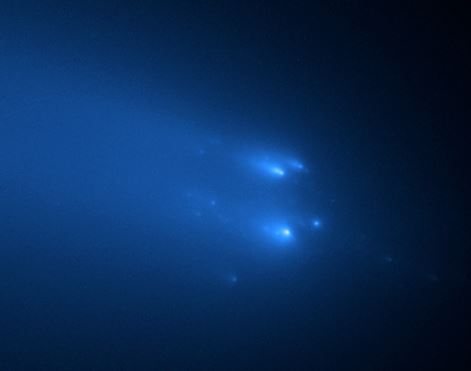
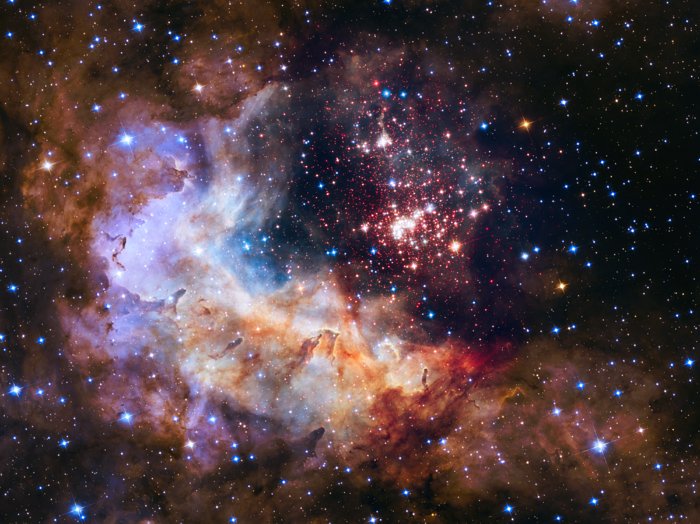
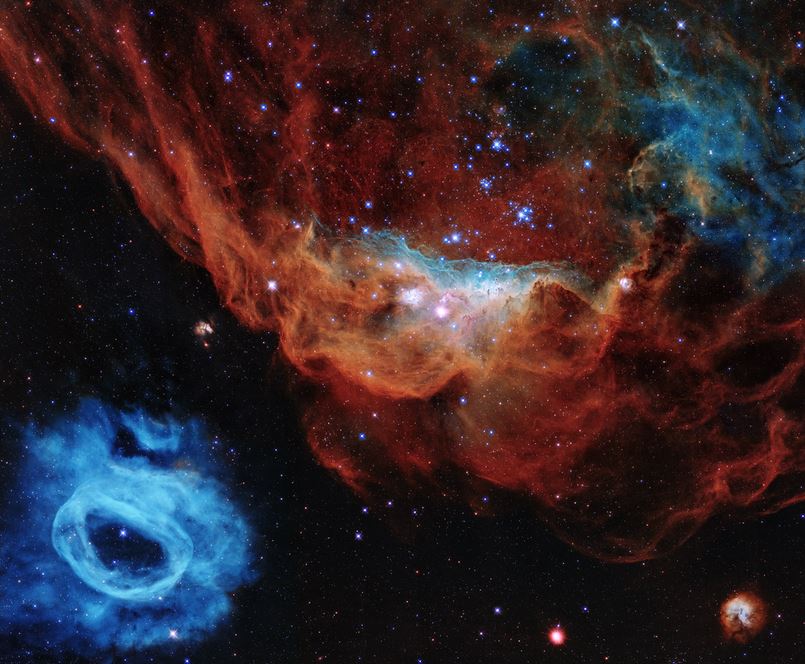
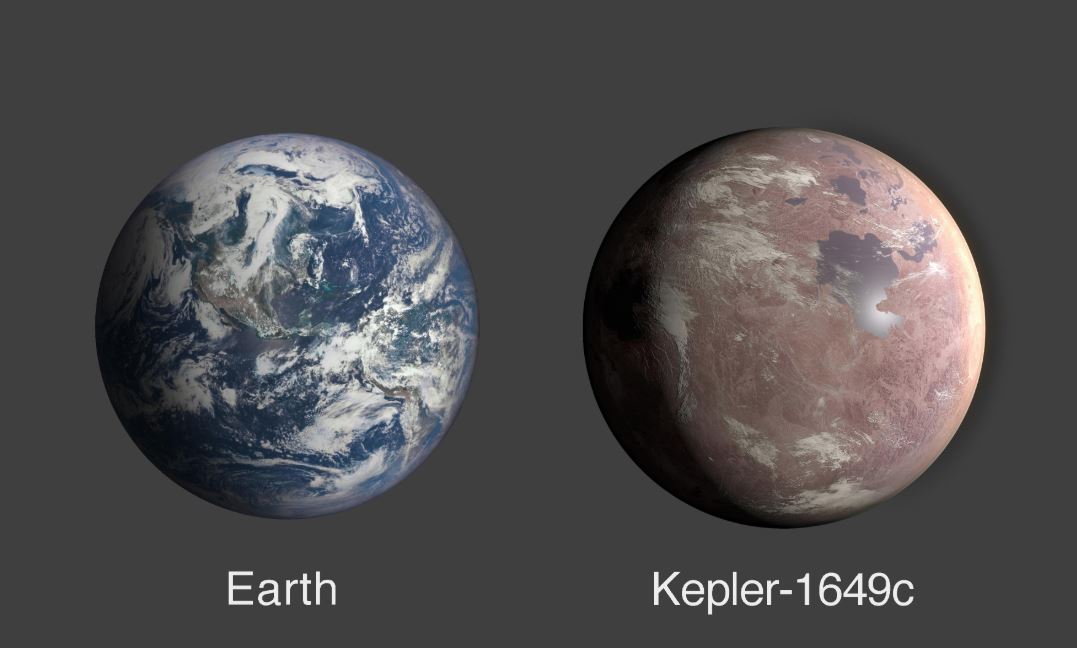

Recent Comments